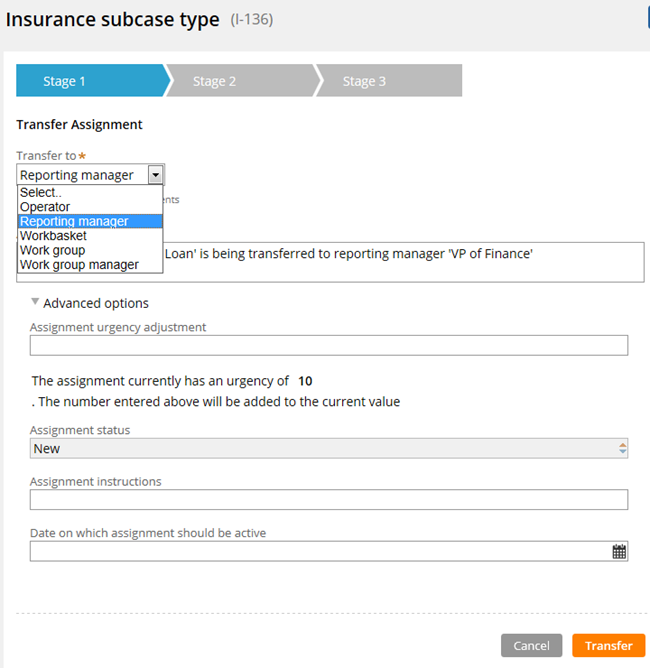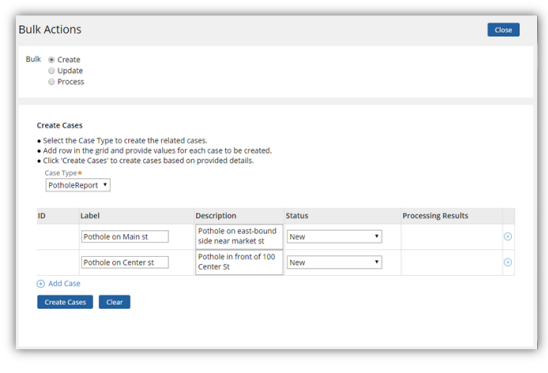Required Oracle optimization parameter
Valid from Pega Version 7.1.3
To optimize performance, set the Oracle parameter optimizer_index_cost_adj to a value between 20 and 25. If this value is not set, the system can run exceedingly slowly, potentially blocking users from login.
Split schema upgrade instructions missing properties
Valid from Pega Version 7.1.3
If you upgraded from 5.x, 6.x, or 7.x using the instructions in previous versions of the upgrade guide, you may have neglected to set the properties below in your migrateSystem.properties file when you migrated your upgraded schema to the source system:
pega.rules.objects.generate=true
pega.rules.objects.apply=true
If these properties were not set during an upgrade that splits the schema, your environment does not have the indexes, triggers, and primary keys on the rules tables.
To check for this issue, see if the pr4_base and pr4_rule rules tables in your existing rules schema are missing primary keys. If they are, use the SQL scripts in the ResourceKit\MigrationRecoveryScripts directory of the release to cleanup duplicate rules that were created due to this issue. Follow the steps below to run the scripts.
To run the scripts on Microsoft SQL, Oracle, or PostgreSLQ
- Take down any app servers using the affected schema.
- Backup your database.
- Replace all instances of @RULES_SCHEMA in <database>_cleanDups.sql with the name of the schema that contains the pr4_base table.
- Run the <database>_cleanDups.sql script on the database with vendor tools (sqlPlus, SQL Server Management Studio, etc).
- Replace all instances of @RULES_SCHEMA in <database>_fix_vw_table.sql with the name of the schema that contains the pr4_base table.
- Run the <database>_fix_vw_table.sql script on the database with vendor tools (sqlPlus, SQL Server Management Studio, etc).
- Generate and apply the ddl using the command line generateDDL command. Check the installation guide for your database or the upgrade guide for details about how to use the generateDDL command line script.
- Rebuild the indexes for the tables in your rules schema using vendor tools. This is necessary so that your system runs at an optimum speed.
- Optionally upgrade to the latest release, at this point your database is ready to be upgraded or used depending on your needs.
To run the scripts on DB2 for LUW or z/OS
- Take down any app servers using the affected schema.
- Backup your database.
- Run the <database>_cleanDups.sql script on the database with vendor tools (UDB CLP, Data Studio, etc) to create the CLEANSE_RULES_DUPS stored procedure.
- Run the query Call CLEANSE_RULES_DUPS(‘<rulesSchema>’); where <rulesSchema> is the name of schema that contains the pr4_base table.
- After the previous step is complete drop the CLEANSE_RULES_DUPS procedure.
- Replace all instances of @RULES_SCHEMA in <database>_fix_vw_table.sql with the name of the schema that contains the pr4_base table.
- Run the <database>_fix_vw_table.sql script on the database with vendor tools (UDB CLP, Data Studio, etc).
- Generate and apply the ddl using the command line generateDDL command. Check the installation guide for your database or the upgrade guide for details about how to use the generateDDL command line script.
- Rebuild the indexes for the tables in your rules schema using vendor tools. This is necessary so that your system runs at an optimum speed.
- Optionally upgrade to the latest release. At this point your database is ready to be upgraded or used depending on your needs.
Synchronized database and application server settings
Valid from Pega Version 7.1.3
Configure your database and application server to use the same time zone and character encoding to avoid conflicts.
Case Management
Valid from Pega Version 7.1.3
This release had a focus on extending key capabilities to improve the ease of configuration based on early adopter feedback. Improvements were made in run-time performance, especially in high volume situations with complex case configurations. A series of cosmetic changes and fixes are included.
- The Wait shape now supports dynamic references.
- Issues were addressed with the CreatePDF and the CascadingApproval Smartshapes.
- Attachments have been improved.
- Issues with the Create Case Type functionality were addressed.
- The Pega Pulse functionality has been improved, including its performance.
- When auditing a work item, History is now the default tab.
System Management
Valid from Pega Version 7.1.3
The PRPC installer has been enhanced to handle additional error conditions related to partial installs and duplicate keys; additionally, the hotfix rollback feature has been improved, and the Rulebase compare tool now supports HTTP(S) environments.
- Rollback feature has been enhanced.
- RuleBase Compare will work for secure (HTTPS) environments as well as non-secure (HTTP) environments.
- Install will gracefully handle the presence of a duplicate key during import.
- When install fails, system will set tables back to original state.
- Remote MBean methods will now work on multi-servant load-balancing systems.
- Enhancements were made to harnesses in Split Schema systems.
Certain flow actions deprecated and replaced
Valid from Pega Version 7.1.7
To ensure compatibility with supported browsers and mobile devices and to enhance ease of design, the following flow actions are deprecated and replaced. As a best practice, use the replacement actions for new development. The deprecated rules are still supported and do not have to be updated.
| Deprecated | Replacement |
|---|---|
| Transfer | Transfer Assignment |
| TransferAdvanced | " |
| TransferToManager | " |
| TransferToWorkbasket | " |
| Approve | Approval |
| Reject | " |
| AttachAFile | Attach Content |
| pyAdjustSLA | Adjust Assignment SLA |
| pyAdjustSLATimes | " |
| pyChangeAssignmentSLA | " |
| pyUpdate | Update Case |
For example, the new Transfer Assignment action supports the most common routing options such as operator, workbasket, and reporting manager. Advanced options allow users to escalate, set due dates, update status, and provide instructions.

Transform Assignment form
See Atlas - Standard Flow Actions (Local).
Service levels are available on stage steps
Valid from Pega Version 7.1.7
For greater flexibility when configuring stages, you can associate a service level (SLA) with a step within the context of the stage only. Because this SLA overrides the one associated (if defined) with a a step, other steps that employ the same flow are not affected and can be configured independently.
See Using the Stages & Processes tab.
Managers can create and update cases using the Bulk Actions tool
Valid from Pega Version 7.1.7
The capabilities of the Bulk Actions tool have been expanded so that managers can go beyond simply being able to make bulk updates to existing cases. They can now:
- Create top-level cases for any case type in your application. By default, you can specify the label, description, and work status for each case.
- Define the case information you want to display on the grid by overriding the section pyBulkUpdate and configuring the columns.
- Update the case information you created in the Bulk Actions tool.

Create Cases option in the Bulk Actions tool
See Case Manager Portal — How to process assignments and cases in bulk.
Define distinct names to implementation and framework class layers in Application Express
Valid from Pega Version 7.1.7
When generating both implementation and framework applications in Application Express, you can now name the framework application and workpool class layers independently. This eliminates the need to update a framework's class structure in the new application. Previously, the framework layers used the same names as the implementation and could not be updated.

Class structure name fields in Advanced Configuration dialog
See Application Express — Advanced Configuration.
New case types contain one stage
Valid from Pega Version 7.1.7
When you create a new case type in the Cases Explorer or in Application Express, the system creates only one default stage. A single starting stage provides an intuitive design experience and eliminates the need to delete unused stages. Previously, a new case type contained three default stages.

